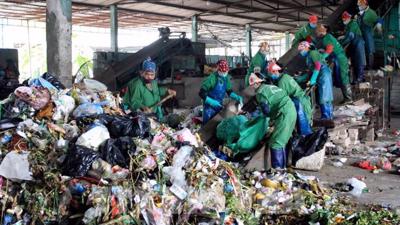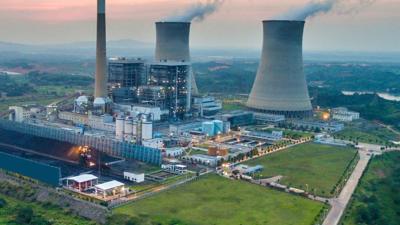Annual economic growth target attainable
Ms. Nguyen Thi Huong, Director General of the General Statistics Office (GSO), tells VET’s Anh Nhi about the economic results in the first nine months and the forecast for the final quarter as Vietnam recovers from Typhoon Yagi.

The agriculture, forestry, and fisheries sector was the most severely affected by Typhoon Yagi. What was the extent of the impact?
Typhoon Yagi, which struck Vietnam’s north in early September, is considered the strongest typhoon to have hit the country in 30 years. The typhoon and its aftermath directly impacted 26 northern cities and provinces, causing widespread damage. While several economic sectors were affected by strong winds, flooding, and landslides, agriculture, forestry, and fisheries production suffered the most. Preliminary estimates suggest that Typhoon Yagi caused over VND80 trillion ($3.22 billion) in damage to the north.
In the third quarter of 2024, the agriculture, forestry, and fisheries sector grew 2.58 per cent; slightly better than in the same period of 2021 but lower than in 2020, 2022, and 2023. Agricultural activities showed the slowest growth since 2020, with an increase of just 2.03 per cent, largely due to the loss of rice fields and livestock in northern provinces during the storm.
Several provinces and cities saw significant declines in growth, including Bac Giang (-12.94 per cent), Thai Nguyen (-10.81 per cent), Quang Ninh (-6.97 per cent), and Hai Phong (-5.64 per cent). However, forestry and aquaculture were less affected, contributing little to the overall decline. Forestry grew 4.32 per cent due to strong wood exports to the US, China, and Europe, while aquaculture in the Mekong Delta has recovered strongly, increasing 3.89 per cent.
Due to the typhoon, the sector’s overall growth in the first nine months of 2024 was only some 3.2 per cent; lower than in 2021-2023. Agriculture grew 2.92 per cent, forestry 4.96 per cent, and fisheries 3.73 per cent. The 26 affected cities and provinces experienced significant losses in agriculture, with flooded crops, damaged aquaculture, and destroyed infrastructure, particularly in Quang Ninh, Hai Phong, and several other localities. Despite these regional impacts, the national growth of the agriculture, forestry, and fisheries sector remained stable, contributing just over 20 per cent to the country’s total growth.
What about growth in other sectors?
In contrast to the decline in agriculture, forestry, and fisheries, the industrial sector recorded growth of 9.59 per cent in the third quarter; the highest quarterly increase this year. The manufacturing sector was the main contributor, achieving impressive growth of 11.41 per cent; the highest for the third quarter since 2020. This growth was partly fueled by a recovering export market, which led to manufacturers receiving more new orders for the remaining months of the year, and it is also measured against a relatively low growth baseline from 2023.
Unexpected factors bolstered industrial growth, including strong oil refining performance post-maintenance, increased electronics orders, and the textile sector capitalizing on international demand amid global challenges. The full operation of the 500 kV national power transmission line, Circuit 3, reduced reliance on non-renewable energy and promoted renewables like hydropower, ensuring stable electricity for production and consumption. This support enabled industrial growth to meet expectations and offset losses in agriculture, forestry, and fisheries.
The 26 cities and provinces hit by Typhoon Yagi faced industrial challenges due to factory damage and widespread power outages, but the overall impact was minimal thanks to contingency plans. Cities and provinces like Hanoi, Hai Phong, Quang Ninh, Vinh Phuc, Thai Nguyen, and Bac Ninh posted positive growth in their Index of Industrial Production (IIP), with Hanoi increasing over 5 per cent and others growing between 7 and 12 per cent.
Moreover, the service sector continued to play a significant role in growth. While some service industries, like tourism and accommodation, were directly affected by Typhoon Yagi, others remained stable.
As you mentioned, the effect of Typhoon Yagi on the agriculture, forestry, and fisheries sector was offset by growth in other areas. Do you think the annual GDP growth target will be met?
Despite the impact of Typhoon Yagi, GDP in the third quarter of 2024 was 7.4 per cent. This resulted in a 6.81 per cent increase in the first nine months of the year; a notable rise from the 4.4 per cent recorded in the same period of 2023.
These figures indicate that the economy experienced positive growth in both the third quarter and the first nine months, even with a decline in agriculture, forestry, and fisheries. This decline has been balanced by strong growth in the industrial sector, while the service sector has continued to see steady growth due to consistent production and consumption demand, creating positive momentum for the fourth quarter of 2024 and the year as a whole.
Based on economic performance in the third quarter and the first nine months, we believe that achieving the annual economic growth target set by the government, of 6.5-7 per cent, is attainable. To reach 6.5 per cent, growth in the fourth quarter will need to be 5.7 per cent, to reach 6.8 per cent it will need to be 6.76 per cent, and to reach 7 per cent will need to be 7.5 per cent.
With the current growth results and anticipated trends over the remainder of the year, it is highly probable that growth for 2024 overall will reach the upper limit of the anticipated scenarios.
What risks could the economy face in the immediate future?
In addition to favorable elements such as consumer stimulus policies, macro-economic stability, and a significant increase in FDI, Vietnam’s economy is still confronted with various risk factors that need to be acknowledged.
Firstly, though the tourism sector has shown positive developments, it has yet to reach its full potential and has not met expectations. There is a need for a serious and systematic approach to developing tourism products to provide a substantial boost to economic growth.
Secondly, businesses are grappling with three major issues: market conditions, capital access, and legal frameworks. Some regulations, administrative procedures, standards, and business conditions remain overly complicated and have not been effectively streamlined.
Thirdly, companies must adhere to new standards, including green criteria, sustainable development practices, and environmental, social, governance (ESG) requirements, which demand significant investment resources. Unfortunately, the timeframe for these transitions is limited, as many countries plan to implement these standards by 2026.
Fourthly, while the financial and monetary markets, as well as the real estate and corporate bond markets, have stabilized, there are still numerous challenges to address, such as credit growth, tackling bad debts, addressing weak banks and “zero dong” banks, resolving obstacles for large real estate projects, coping with pressure from corporate bond maturities, and improving the stock market.
Lastly, climate change and extreme weather events are increasingly posing serious threats to human welfare, production, and economic development.
What solutions do you propose to achieve the growth target?
To stimulate economic growth in the final months of 2024 and lay the groundwork for future progress, several key measures should be effectively implemented.
First, it is crucial to ensure macro-economic stability by managing inflation and stabilizing exchange rates. While focusing on growth, the government must continue policies aimed at controlling inflation and maintaining stable prices to protect citizens’ purchasing power. A reliable foreign exchange supply is essential to avoid fluctuations that could impact the import of raw materials and the export of goods.
Second, encourage domestic consumption by effectively implementing demand stimulus programs, such as discounts and promotions, and by promoting the use of domestically-produced goods. It is important to enhance the distribution of products through digital platforms and e-commerce.
Third, strengthen exports and international integration by enhancing trade promotion activities, supporting businesses in attending international fairs, seeking new partnerships, and expanding export markets.
Fourth, accelerate public investment disbursement by speeding up funding allocations for public investment projects, particularly in infrastructure, to create momentum for related sectors such as construction, materials production, and logistics, thus facilitating the movement of goods.
Fifth, help businesses enhance competitiveness by promoting technology adoption, innovation, and cost reduction, encourage investment in green technologies to meet EU and US environmental standards, and support companies in digital transformation to improve productivity and reduce costs, while also offering favorable tax, fee, and interest rate policies.
Lastly, improve the business environment by streamlining administrative procedures, enhancing administrative reform, and minimizing barriers that hinder businesses from quickly accessing capital, markets, and government support programs.
Given the ongoing global economic challenges that negatively affect Vietnam’s economic growth, the effective and coordinated implementation of these solutions, coupled with a favorable business environment and political and social stability, is vital for driving economic growth in the final months of 2024.







![[Interactive]: Economic overview - April 2025](https://media.vneconomy.vn/400x225/images/upload/2025/05/06/5a245778-67b1-4874-a8dc-21f8cfed62a6.png)